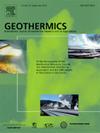Evaluating naphthol and naphthalene as novel geothermal tracers, with potential application in supercritical systems
IF 3.5
2区 工程技术
Q3 ENERGY & FUELS
引用次数: 0
Abstract
Naphthalene disulfonates, particularly 1,5-naphthalene disulfonate (1,5-NDS), are widely used as geothermal tracers, yet their behaviour under extreme thermal and flow conditions remains insufficiently understood. In this study, we examine the formation of 1,5-NDS key breakdown products: naphthalene, 1-naphthol, 2-naphthol, and 1-naphthalene sulfonate (1-NSA), under high-temperature flow-through conditions designed to simulate geothermal reservoirs. Experiments were conducted using geothermal brine at 350 °C and 400 °C across a range of flow rates, employing a custom-built flow-through reactor system. High-performance liquid chromatography (HPLC) analysis was used to quantify reactants and degradation products over time. The results reveal that both temperature and residence time exert strong control on degradation rates and product profiles. At higher temperatures and lower flow rates, the formation of volatile products such as naphthalene and naphthols was favoured, indicating a shift toward desulfonation and aromatic ring rearrangement pathways. These findings provide important constraints on the stability and behaviour of 1,5-NDS in deep, high-temperature geothermal environments and offer a basis for refining tracer selection and test design in supercritical and near-supercritical systems.
评价萘酚和萘作为新型地热示踪剂在超临界系统中的潜在应用
萘二磺酸盐,特别是1,5-萘二磺酸盐(1,5- nds),被广泛用作地热示踪剂,但其在极端热和流动条件下的行为仍未得到充分了解。在这项研究中,我们研究了1,5- nds关键分解产物:萘、1-萘酚、2-萘酚和1-萘磺酸盐(1- nsa)在模拟地热储层的高温渗流条件下的形成。实验使用350°C和400°C的地热盐水,在一定的流量范围内进行,采用定制的流式反应器系统。高效液相色谱(HPLC)分析用于定量反应物和降解产物随时间的变化。结果表明,温度和停留时间对降解速率和产物形态有很强的控制作用。在较高的温度和较低的流速下,有利于形成萘和萘酚等挥发性产物,表明了向脱硫和芳环重排途径的转变。这些发现为1,5- nds在深部高温地热环境中的稳定性和行为提供了重要的约束条件,并为超临界和近超临界系统中示踪剂的优化选择和测试设计提供了基础。
本文章由计算机程序翻译,如有差异,请以英文原文为准。
求助全文
约1分钟内获得全文
求助全文
来源期刊

Geothermics
工程技术-地球科学综合
CiteScore
7.70
自引率
15.40%
发文量
237
审稿时长
4.5 months
期刊介绍:
Geothermics is an international journal devoted to the research and development of geothermal energy. The International Board of Editors of Geothermics, which comprises specialists in the various aspects of geothermal resources, exploration and development, guarantees the balanced, comprehensive view of scientific and technological developments in this promising energy field.
It promulgates the state of the art and science of geothermal energy, its exploration and exploitation through a regular exchange of information from all parts of the world. The journal publishes articles dealing with the theory, exploration techniques and all aspects of the utilization of geothermal resources. Geothermics serves as the scientific house, or exchange medium, through which the growing community of geothermal specialists can provide and receive information.
 求助内容:
求助内容: 应助结果提醒方式:
应助结果提醒方式:


